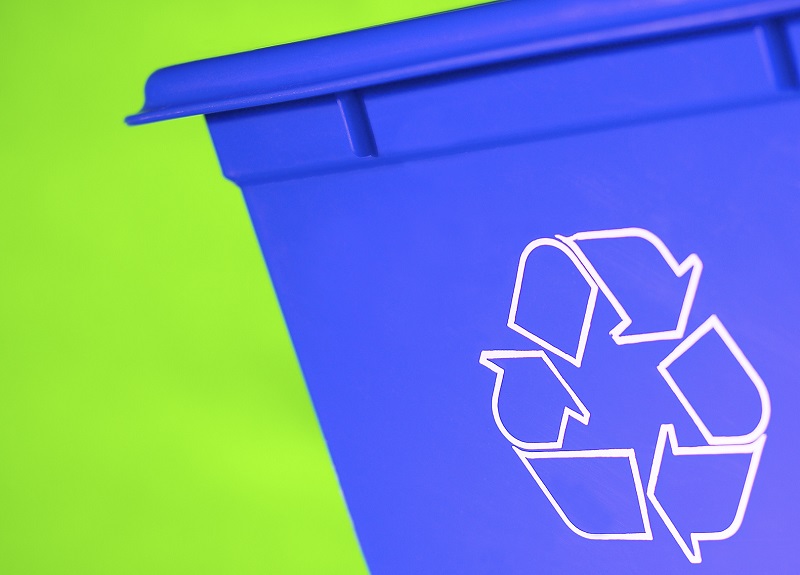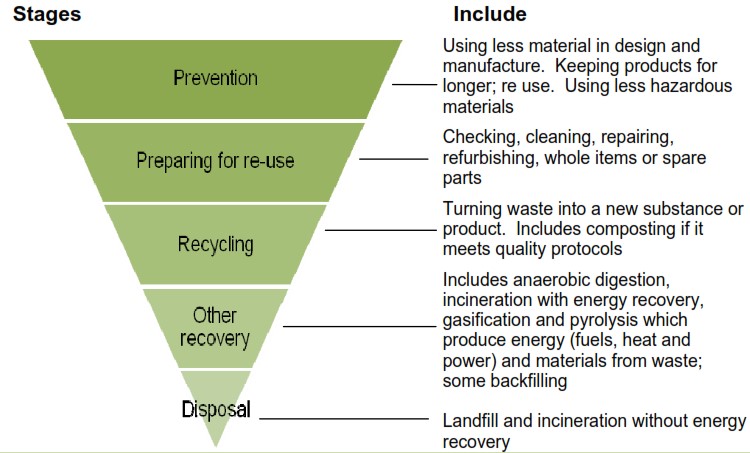Reduce, reuse, recycle

|
Contents |
[edit] Introduction
Reduce, reuse and recycle is a motto used by environmentalists to reduce waste, minimise consumption and ensure the best overall approach is adopted for the environment and human health. Such programmes when managed at national and/or local levels can save money, energy and natural resources.
Reduce, reuse and recycle are part of the ‘waste hierarchy’ guidance tool which ranks waste management options according to what is best for the environment and also considers resource and energy consumption. It aims to extract from products the maximum practical benefits and generate minimal waste. The priorities in the hierarchy are based on sustainability.

|
| The waste hierarchy pyramid. |
The waste management hierarchy features a distinct order of preference – usually represented by a pyramid diagram – which is designed to facilitate reduction and management of waste. The pyramidal structure emphasises options from those that are most favoured to those least favoured.
In the UK, this falls under the Waste (England and Wales) Regulations 2011, which came into force on 29 March 2011.
The origins of waste hierarchy guidance stretch back to 1975, when the European Union’s Waste Framework Directive introduced the concept into European waste policy. It emphasised waste minimisation, protection of the environment and human health.
[edit] Reduce
In the first instance, reduction gives priority to preventing waste as a basic step. In other words, through judicious purchasing and use behaviours, the amount of waste can be reduced. Reduced waste means less material to process, ie prepare it for reuse, recycling, recovery and disposal.
Reduction/prevention may include;
- Using less material in design and manufacture.
- Consuming only what is needed, avoiding pointless purchases. Sharing rarely-used items.
- Keeping products for longer.
- Buying only products that can be reused.
- Hire or lease items.
- Buy products with no or minimal packaging.
- Regular maintenance can extend the lifecycle of a product hence lower the need for new material.
[edit] Reuse
Reuse and preparing for reuse may involve:
- Checking cleaning, repairing, refurbishing, whether whole items or parts.
- Reusing items such as carrier bags, envelopes, newspaper, cardboard, bubble wrap, jars, pots, old clothes, packaging, tyres, used wood and building materials and so on.
- Buying a wide range of products from clothes to building materials at specialist recycling centres.
- Reusing containers.
- Maintaining and repairing products as far as possible, eg, clothes, tyres, bricks, roof slates
- Regular maintenance.
- Reusing surplus material from other organisations.
[edit] Recycle
Turning materials that would otherwise be thrown away into new substances or products. The benefits include:
- Reduced waste sent to landfill.
- Conserves natural resources.
- Less pollution from lower levels of extraction and manufacturing activities.
- May create employment opportunities.
[edit] Other recovery methods
The three steps above, once implemented, can lead to other recovery methods, such as anaerobic digestion, incineration with energy recovery, and finally disposal involving landfill and incineration without energy recovery.
The waste hierarchy as described above applies to most materials. However, the UK government concedes that for some materials, it may be better for the environment if they undergo waste management options that are not in keeping with the waste hierarchy order. These materials include:
- Food – research has shown that anaerobic digestion is environmentally better than composting and other recovery options;
- Garden waste and mixtures of food waste – dry anaerobic digestion followed by composting is environmentally better than composting alone,
- For lower grade wood, energy recovery options are more suitable than recycling. To determine the grade of wood handled, see Wood Recyclers Association grading structure for UK derived, non-virgin wood Applying the Waste Hierarchy: Evidence Summary, section 19.
[edit] Related articles on Designing Buildings
- Bin blight.
- BREEAM Operational waste.
- Building Back Better: Circularity and BREEAM.
- Casing.
- Circular economy.
- Environmental plan.
- Glass bottle floor foundation.
- Mean lean green.
- Recyclable construction materials.
- Recycling.
- RIBA Stirling Prize winners' open letter declaring climate and biodiversity emergency.
- Site waste management plan.
- Sustainability.
- The Carbon Project: infrastructure and the circular economy.
- UandI Think event with Studio SWINE.
- Waste hierarchy for construction.
- Wishcycling.
About the wiki
Anyone is welcome to use and contribute to the wiki in different ways.
[edit] Engaging with the wiki
You can:
- Contribute to existing articles
- Create articles
- Share articles through social media and other channels
- Contact the CIRCuIT project to let us know what you think and how we can improve
[edit] Add your own content
To contribute to or create an article, you can follow these steps:
- Register as a user
- Read through the editorial policy and guidance on writing and contributing to articles
- See the detailed help page on tips on writing wiki articles
- Try editing a test article
- If editing an article, select 'Edit this article' underneath the article title
- If creating a new article, select 'Create an article'. In the 'Select categories' area, expand the 'Industry context' list and tag 'Circular economy' to add your article to this wiki
[edit] Who is this wiki for?
The articles contain information on implementing circular economy approaches in construction that could be relevant to:
- Architects
- Construction contractors
- Designers
- Developers, owners, investors
- Engineers
- Landowners
- Manufacturers and supplier
- Universities and research
- Urban planners
[edit] About CIRCuIT
The Circular Economy wiki is supported by the Circular Construction in Regenerative Cities (CIRCuIT) project, which is funded by the European Union's Horizon 2020 research and innovation programme. CIRCuIT is a collaborative project involving 31 ambitious partners across the entire built environment chain in Copenhagen, Hamburg, Helsinki Region and Greater London. Through a series of demonstrations, case studies, events and dissemination activities, the project will showcase how circular construction practices can be scaled and replicated across Europe to enable sustainable building in cities and the transition to a circular economy on a wider scale.





